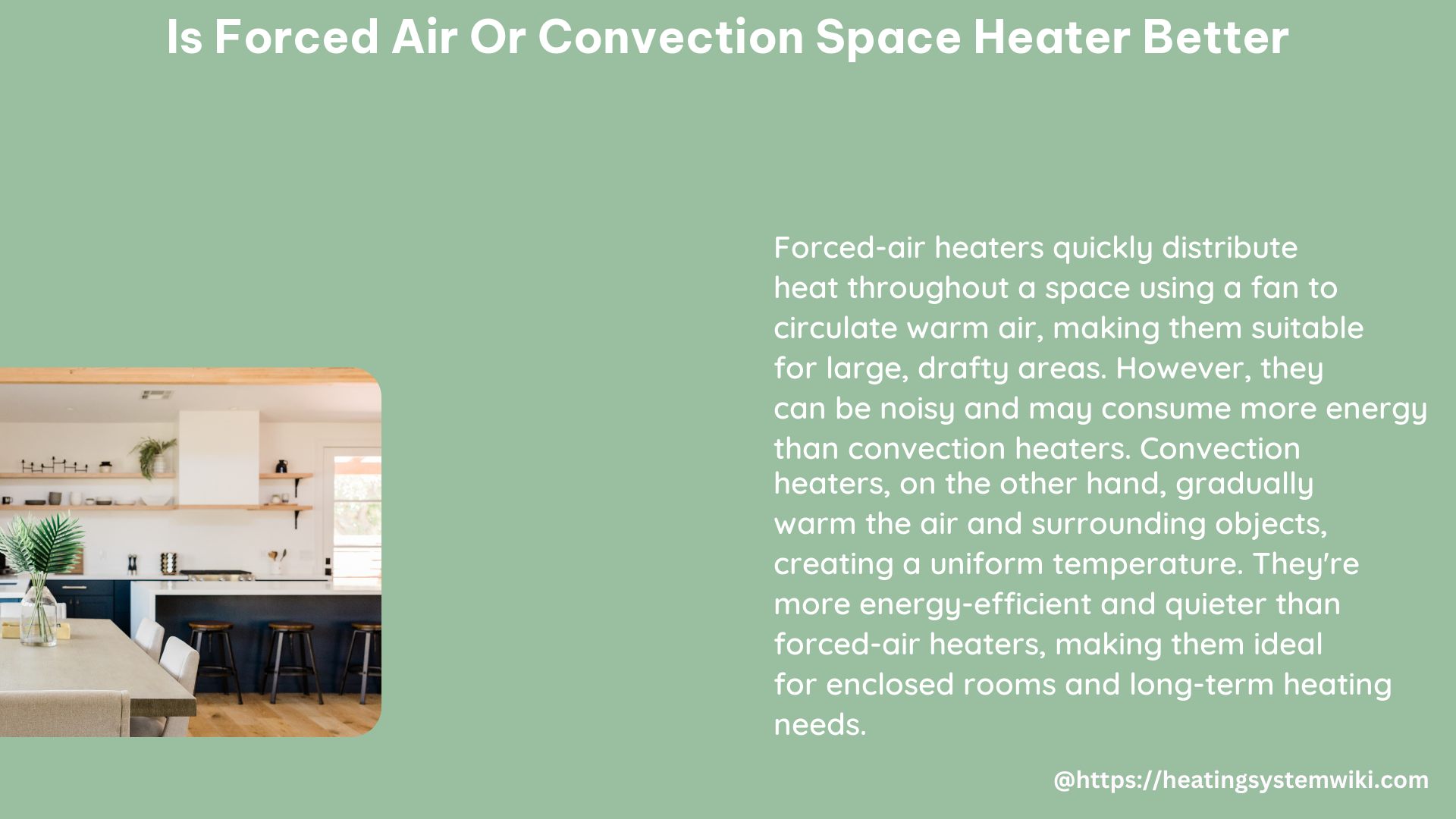Forced air and convection heaters are two popular options for space heating, each with its own unique advantages and disadvantages. The choice between the two often depends on the specific needs and requirements of the user, such as the size and layout of the space, the desired heating method, and the user’s energy efficiency preferences.
Forced Air Heaters: Efficient and Powerful
Forced air heaters work by blowing heated air into a room using a fan. This method of heating is known for its ability to quickly and efficiently heat up a space. Forced air heaters are often rated in cubic feet per minute (CFM), which describes the unit’s output in terms of air volume. A higher CFM rating generally indicates a more powerful and efficient heater.
For example, the Lasko 754200 Ceramic Heater has a CFM rating of 190, which is suitable for heating spaces up to 300 square feet. In contrast, the Vornado AVH10 Vortex Heater has a CFM rating of 167, making it suitable for smaller spaces up to 250 square feet.
Forced air heaters are often used in large, open areas such as garages, warehouses, and industrial spaces, where they can quickly and effectively heat a large volume of air. They are also popular in residential settings, particularly in homes with central heating systems, as they can be used to supplement or replace the main heating system.
Convection Heaters: Steady and Even Heat

Convection heaters, on the other hand, work by heating up the air in a room indirectly. They use a heating element to warm up the air around them, which then rises and circulates throughout the room. Convection heaters are often rated in British thermal units per hour (BTU/h), which describes the amount of heat the unit can produce.
For instance, the Lasko 5775 Electric Ceramic Heater has a BTU/h rating of 5,118, which is suitable for heating spaces up to 300 square feet. In comparison, the Vornado MVH Vortex Heater has a BTU/h rating of 3,415, making it suitable for smaller spaces up to 250 square feet.
Convection heaters are known for their ability to provide a steady, even heat that can be felt throughout the room. They are often used in smaller spaces such as bedrooms, offices, and living rooms, where a more consistent and comfortable heating experience is desired.
Energy Efficiency: Tradeoffs and Considerations
In terms of energy efficiency, both forced air and convection heaters have their own advantages and disadvantages. Forced air heaters can be more energy-efficient than convection heaters because they can heat up a space more quickly. However, they can also be less efficient in the long run because they require more energy to maintain a consistent temperature.
Convection heaters, on the other hand, can be more energy-efficient in the long run because they provide a steady, even heat that can be felt throughout the room. However, they can take longer to heat up a space initially.
It’s important to consider the specific energy efficiency needs and preferences of the user when choosing between forced air and convection heaters. For example, if the user is looking to quickly heat up a large space, a forced air heater may be the better choice. If the user is more concerned with maintaining a consistent and comfortable temperature in a smaller space, a convection heater may be the better option.
Factors to Consider
When choosing between forced air and convection heaters, it’s important to consider the following factors:
- Space Size and Layout: Forced air heaters are better suited for larger, open spaces, while convection heaters are more suitable for smaller, enclosed spaces.
- Heating Speed: Forced air heaters can heat up a space more quickly, while convection heaters provide a more steady and even heat.
- Energy Efficiency: Forced air heaters can be more energy-efficient in the short term, but convection heaters may be more efficient in the long run.
- Noise Level: Forced air heaters tend to be louder due to the fan, while convection heaters are generally quieter.
- Safety: Both types of heaters have safety features, but convection heaters may be slightly safer as they don’t have exposed heating elements.
Ultimately, the choice between forced air and convection heaters depends on the specific needs and preferences of the user. It’s important to carefully consider all of these factors before making a decision.
References
- Grainger: Portable Heater Guide: Choosing the Best Space Heater – https://www.grainger.com/know-how/equipment/kh-video-types-portable-space-heaters
- Reddit: ELI5: Which type of space heater is the most efficient and how do they all work? – https://www.reddit.com/r/explainlikeimfive/comments/3xpdya/eli5which_type_of_space_heater_is_the_most/
- Home Electrical: Radiant vs. Convection vs. Forced-Air Heating Systems – https://www.homelectrical.com/heating-radiant-vs-convection-vs-forced-air.6.html
